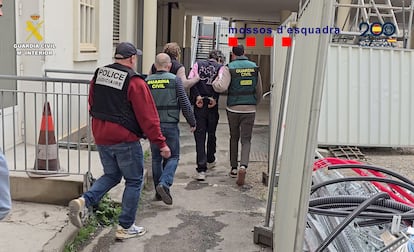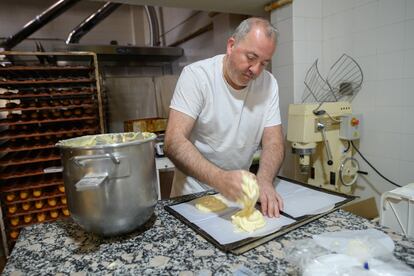The laborious investigation that allowed a serial killer to hunt | Spain
Criminology defines serial murderers as those who kill three or more victims at different times and different places. According to this definition, There the Mourabit Ahmmar, a 54 -year -old Spanish and Moroccan originit is allegedly one of them. The Mourabit – which had already been sentenced in 2018 for a crime of jihadism to three years in jail – He was arrested in France on March 25 as the alleged author of the crimes of three farmers committed just over a year earlier in Navarra and Lleida with only 44 days apart.
These are the research milestones that, according to sources close to the investigations, allowed The Central Civil Guard Operating Unit (UCO) hunt the alleged author of Pedro Oyón’s deaths (68 years) on November 22, 2023 in Tudela (Navarra); José Luis Aguado (80) in Ribaforada (also in the Regional Community) on December 21 of the same year; and Ramón Rosell (84), occurred on January 5, in Vilanova de la Barca (Lleida).
Remains in the steering wheel. Aguado was found dead three days before Christmas Eve of 2023. The body, with signs of violence, was found in a garden on the outskirts of Ribaforada to which he had come to work. His car, a red Opel Astra, had disappeared. This was located two weeks later to more than 200 kilometers, in an industrial estate in Lleida. The Criminalistics Service of the Armed Institute then submitted the vehicle to an eye inspection in search of indications of the thief, which they also considered the author of the agricultural death. They found them in the form of small skin remains on the steering wheel and other places in the driver’s seat. From those epithelial cells the DNA was extracted to contrast it with the databases where this information is saved by thousands of criminals. There was no luck. No genetic profile coincided. However, it did allow this crime to relate to that of the other two victims.
95,000 reviewed incidents. If the laboratory did not provide immediate results, they did not review the cameras near the ribaforada crime or the analysis of mobile phone connections in the area. The Civil Guard then decided to look for a needle in a haystack and analyze all the “police interest” facts recorded on dates close to the crime by any police force in a wide radius of action. Including those who did not have criminal appearance, such as the calls of neighbors who claimed to have seen someone to lock. In total there were 95,000 incidents that, finally, contributed a thread to throw: the complaint of a neighbor of Cárcar, a Navarra town of just over 1,100 inhabitants and located 58 kilometers northwest of Tudela, place of the first crime, already 69 of Ribaforada, where the second was committed.
A motorhome. This neighbor had denounced a month and a half before the murder of Aguado that someone had entered a motorhome of his property to sleep. The eye inspection of the interior of the vehicle allowed to recover biological remains of that anonymous Okupa that coincided with those of the person who had killed the three farmers. The UCO then toured all the localities between Cárcar and Ribaforada to one shore and another of the Ebro River in search of testimonies, videos or any other indication about the murderer, already convinced that the course that the criminal had followed was from north to south. That track was found in Azagra (3,750 inhabitants, Navarra), 14 kilometers. There, a person had denounced the suspicious attitude of an individual near his garden, in which he had a camcorder installed. The review of the recordings allowed to obtain the image of a man whom, however, his face was not clearly seen because he wore a hat. Submitted the frame to a computer program that seeks facial and bodily coincidences with those collected in the criminal records, the track threw dozens of suspect names. Among them was the Mourabit.

Male and dark hair. In parallel, 700 kilometers away, the Luís Concheiro Forensic Institute of Forensic Sciences of the University of Santiago de Compostela was going to contribute a new track. The Civil Guard had sent a DNA sample to do a study of the genotype and geographical origin of the unknown murderer. The result allowed to reduce the number of suspects by revealing that it corresponded to a male of Maghreb origin with brown eyes and dark hair. After this description, the suspicions focused on the Mourabit, since in addition to coinciding with their physical features, the agents already knew that it resided in Vitoria (Álava) – a starting point compatible with the journey of the murderer – and that it was in an unknown whereabout jihadism. They had also proven that both Navarra and Lleida were not unknown to him, since he had lived in both areas.

DNA of two brothers. Become the main objective of the investigations, the agents needed an undublished sample of their DNA or, at least, of some close relative to compare it with those collected in the scenes of the crimes and confirm the suspicions. While he continued in an unknown whereabouts, only the second option remained. The head of the Court of Instruction number 3 of Tudela, which carries the causes for the two murders of Navarra, issued an order to obtain biological samples of two siblings of the suspect. The laboratory confirmed shortly after these shared approximately 50% of the DNA with the person who had left the remains found in the steering wheel and, therefore, that they allegedly belonged to El Mourabit. From that moment on, the events rushed. As the car that stole the third murdered in Lleida had appeared in the French town of Béziers (73,000 inhabitants, 280 kilometers from the border with Spain), the judge issued on March 21 a European arrest warrant of detention and delivery (OEDE). The Gala Police, who had already detected the presence of El Mourabit in this city, stopped him four days later near his cathedral after a struggle to reduce it. On April 24 he was delivered on the border of the jonquera. The last serial murderer known in Spain did not want to declare either before the Civil Guard or before the judge. Why he murdered the three farmers – except vehicles to the last two victims, did not rob them at all – it is still an unanswered question.







